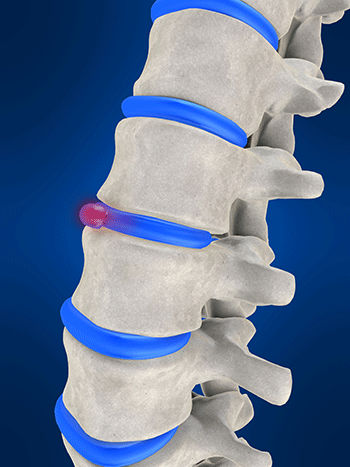Back and neck pain are often caused by a herniated disc. As an Oakleigh chiropractor, Dr Liveriadis often cares for patients who have pain caused by disc herniation and related issues.
Understanding Disc Herniation
 Within the spine, there are 33 vertebrae. Between each of these is a cushion known as an intervertebral disc made of a soft, gel-like substance surrounded by a tough, fibrous ring. If this exterior ring becomes ruptured, the soft interior of the disc can bulge outward, placing pressure on the nerves and ligaments.
Within the spine, there are 33 vertebrae. Between each of these is a cushion known as an intervertebral disc made of a soft, gel-like substance surrounded by a tough, fibrous ring. If this exterior ring becomes ruptured, the soft interior of the disc can bulge outward, placing pressure on the nerves and ligaments.
Nerve compression caused by a bulging disc may result in tingling, pins and needles sensations, numbness, muscle weakness, neck pain, sciatica, and back pain. A herniated disc does not always result in pinched nerves. A torn spinal disc stimulates the body to release inflammatory chemicals. These can directly cause pain.
A herniated disc may also be caused by a separation of the connective tissue between the vertebrae and the disc. This is known as endplate junction failure. Recent research suggests a significant number of cases diagnosed as lumbar disc herniation are actually examples of endplate junction failure, not a ruptured disc.
Disc Herniation Causes
A herniated disc may occur when twisting, bending, or picking up something heavy or with incorrect form. Other causes include a hit to the back, a fall, auto collisions, or work injuries. Aging also plays a significant role in increasing the risk of disc herniation. As you grow older, the spinal discs have a reduced water content, making them more likely to rupture or tear. Other risk factors include genetics, being overweight, and working a job that requires repeated lifting of heavy objects.
Disc Herniation Types
 A lumbar or lower back disc herniation is the most common. It causes lower back pain, often extending into the hips, buttocks, or legs. Patients may also experience sciatica pain if the herniated disc affects the sciatic nerve, which runs from the lower back through the buttocks and thighs.
A lumbar or lower back disc herniation is the most common. It causes lower back pain, often extending into the hips, buttocks, or legs. Patients may also experience sciatica pain if the herniated disc affects the sciatic nerve, which runs from the lower back through the buttocks and thighs.
Cervical disc herniation occurs in the neck. As such, it usually causes neck pain, sometimes accompanied by symptoms in the shoulders, arms, or wrists.
Thoracic disc herniation occurs in the mid to upper back, an area known as the thoracic spine. While this form of disc herniation is possible, it is by far the least common type, affecting less than 4% of disc herniation patients.
Understanding the Terms
Disc herniation is also known as a slipped disc or ruptured disc. However, 'slipped disc' is a misnomer, since the spinal disc cannot 'slip' from its position on the vertebrae. Rather, the disc is ruptured, torn,or irritated instead of slipping out of position.
Chiropractic Care for Herniated Discs
At North Road Chiropractic, we use chiropractic adjustments to alleviate pressure on the nerve being affected by the disc herniation. This allows the nerve to heal naturally. We also suggest exercise rehabilitation, which strengthens spinal ligaments and core muscles. Studies have shown this to be an effective approach for treating herniated discs. Call North Road Chiropractic to discuss how chiropractic care can help to alleviate your disc herniation pain in Oakleigh, Mt. Waverley, Clayton, and East Bentleigh, Melbourne.
References
Rajasekaran S, et al. ISSLS Prize Winner: The anatomy of failure in lumbar disc herniation: an in vivo, multimodal, prospective study of 181 subjects. Spine 2013; 38(7): 1491-1500.
Robert JA and Wolfe TM. Chiropractic management of a veteran with lower back pain associated with diffuse idiopathic skeletal hypertrophy and degenerative disk disease. Journal of Chiropractic Medicine 2012; 11(4): 293–299.
Peterson CK, et al. Outcomes from magnetic resonance imaging–confirmed symptomatic cervical disk herniation patients treated with high-velocity, low-amplitude spinal manipulative therapy.: a prospective cohort study with 3-month follow-up. Journal of Manipulative and Physiological Therapeutics 2013; doi 10.1016/j.jmpt.2013.07.002).
Peterson, CK, et al. Symptomatic Magnetic Resonance Imaging-confirmed lumbar disk herniation patients: a comparative effectiveness prospective observational study of 2 age- and sex-matched cohorts treated with either high-velocity, low-amplitude spinal manipulative therapy or imaging-guided lumbar nerve root injections. Journal of Manipulative and Physiological Therapeutics 2013; doi: 10.1016/j.jmpt.2013.04.005.
